
In Western ecclesiastical architecture, a cathedral diagram is a floor plan showing the sections of walls and piers, giving an idea of the profiles of their columns and ribbing. Light double lines in perimeter walls indicate glazed windows. Dashed lines show the ribs of the vaulting overhead. By convention, ecclesiastical floorplans are shown map-fashion, with north to the top and the liturgical east end to the right.

In church architecture, the chancel is the space around the altar, including the choir and the sanctuary, at the liturgical east end of a traditional Christian church building. It may terminate in an apse.
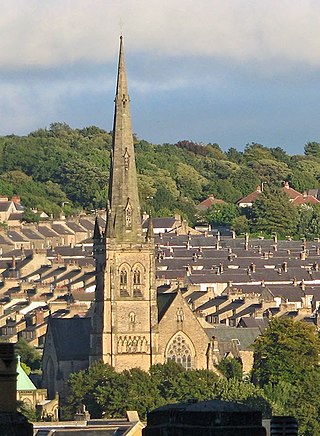
Lancaster Cathedral, also known as The Cathedral Church of St Peter and Saint Peter's Cathedral, is a Roman Catholic cathedral in Lancaster, Lancashire, England. It was a Roman Catholic parish church until 1924, when it was elevated to the status of a cathedral. It started as a mission church in 1798, and the present church was built on a different site in 1857–59. It was designed by E. G. Paley in the Gothic Revival style and is a grade II* listed building. In 1901 a baptistry was added by Austin and Paley, and the east end was reordered in 1995 by Francis Roberts. The cathedral is in active use, arranging services, concerts and other events, and is open to visitors.

The Episcopal Diocese of Indianapolis, formerly known as the Episcopal Diocese of Indiana, is a diocese in Province V of the Episcopal Church. It encompasses the southern two-thirds of the state of Indiana. Its see is in Indianapolis, Indiana, at Christ Church Cathedral. According to the diocesan newsletter, the diocese has 10,137 communicants in 49 parishes. The current bishop is Jennifer Baskerville-Burrows, the first African-American woman to serve as diocesan bishop in the Episcopal Church and the first woman to succeed another woman as a diocesan bishop in the Episcopal Church; Catherine Waynick served as bishop of the diocese from 1997 to 2017.

St. Mary's Episcopal Cathedral, designed by Memphis architect Bayard Snowden Cairns, located near downtown Memphis, Tennessee, is the cathedral church of the Episcopal Diocese of West Tennessee and the former cathedral of the old statewide Episcopal Diocese of Tennessee.
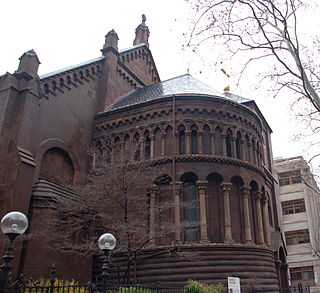
Saint Clement's Church is an historic Anglo-Catholic parish in Logan Square, Center City, Philadelphia. It is part of the Episcopal Diocese of Pennsylvania. The church, designed by architect John Notman, was built in 1856. It originally incorporated a spire more than 200 feet (61 m) tall; this was found to be too heavy for the foundation and was removed in 1869. In 1929, the church building, which includes the parish house and rectory, and weighs 5000 tons, was lifted onto steel rollers and moved forty feet west to allow for the widening of 20th Street. On November 20, 1970, Saint Clement's Church was listed on the National Register of Historic Places.

Christ Church Cathedral is the cathedral for the Episcopal Diocese of Indianapolis. Christ Church parish was formally organized in 1837. The present-day church building was erected in 1857 on Monument Circle at the center of downtown Indianapolis to replace the parish's first church built on the same site. Designed by architect William Tinsley, the English Gothic Revival-style structure is the oldest church building in Indianapolis and Marion County, Indiana, that has remained in continuous use. It is also the oldest building on Monument Circle. Christ Church is known for its music, especially its pipe organs, one of which was donated by Ruth Lilly, and its professional Choir of Men and Boys and Girls' Choir. The parish is also known for its community service, including an annual strawberry festival fundraiser and other charitable work. Christ Church Cathedral was added to the National Register of Historic Places on July 10, 1973. It is located in the Washington Street-Monument Circle Historic District.

St. Mary Catholic Church is a parish of the Roman Catholic Church in Indianapolis, Indiana, in the Archdiocese of Indianapolis.

Calvary Episcopal Church is a parish of the Episcopal Diocese of Pittsburgh, Pennsylvania. The parish was founded in 1855.
The Church of the Incarnation is a parish of the Diocese of Dallas of the Episcopal Church, located at 3966 McKinney Avenue in Dallas, Texas.
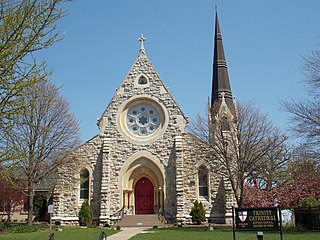
Trinity Episcopal Cathedral, formerly known as Grace Cathedral, is the historic cathedral in the Diocese of Iowa. The cathedral is located on the bluff overlooking Downtown Davenport, Iowa, United States. Completed in 1873, Trinity is one of the oldest cathedrals in the Episcopal Church in the United States. It was individually listed on the National Register of Historic Places in 1974. In 1983 the cathedral was included as a contributing property in the College Square Historic District, which is also listed on the National Register.

St. Paul's Episcopal Cathedral, is located in downtown Des Moines, Iowa, United States. It is the cathedral church of the Episcopal Diocese of Iowa. The building was listed on the National Register of Historic Places as St. Paul's Episcopal Church.

Visby Cathedral, formally Visby Saint Mary's Cathedral, is a cathedral within the Church of Sweden, seat of the Bishop of Visby. It lies in the centre of Visby, the main town on the Swedish island Gotland. It was built as the church of the German traders in the city during the 13th century. The very first church was probably a wooden church, which was later replaced by a stone building. Originally built as a basilica, it was successively expanded and rebuilt during the Middle Ages. At the end of this period it had been transformed to a hall church, which it still is. In 1361, Gotland and the church became part of Denmark. Following the Reformation, it was the only medieval church in the city left in use, and in 1572 raised to the status of cathedral. Since 1645 Gotland and the cathedral have been part of Sweden. A major renovation was carried out in 1899–1903 under the guidance of architect Axel Haig.

Saints Peter and Paul Cathedral is a Roman Catholic cathedral located at Fourteenth and Meridian Streets in Indianapolis, Indiana, United States. It is the seat of the Archdiocese of Indianapolis, and of the Archbishop of Indianapolis, most recently Archbishop Charles C. Thompson. Silas Chatard, the first Bishop of Indianapolis, established the cathedral parish in 1892, and named it after Saint Peter and Saint Paul, two apostles of Christ. The cathedral parish became known for its liturgical celebrations and sacred music performances.
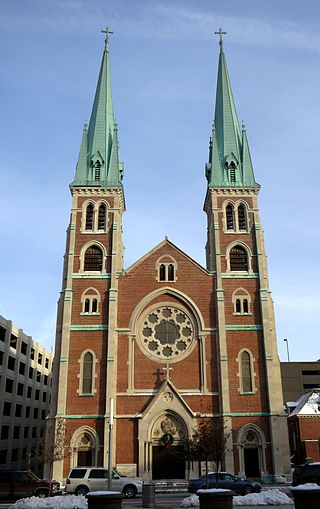
Saint John the Evangelist Catholic Church is a Roman Catholic parish of the Archdiocese of Indianapolis in Indianapolis, Indiana, United States. The parish's origins date to 1837, when it was first named Holy Cross parish. In 1850 it was renamed Saint John the Evangelist parish, and is the oldest Catholic parish in the city and in Marion County, Indiana. Considered the mother of the Catholic parishes in Indianapolis, it played an important role in development of the Catholic Church in the city. Saint John's Church served as the pro-cathedral of the diocese from 1878 until 1906; its rectory served as the bishop's residence and chancery from 1878 until 1892. In 1900 the church served as the site of first episcopal consecration held in Indianapolis.

Grace and Holy Trinity Cathedral is an Episcopal cathedral in the Quality Hill neighborhood of downtown Kansas City, Missouri, United States. It is the seat of the Episcopal Diocese of West Missouri.

Saint Thomas's Church is a historic Roman Catholic church in St. Helier, Jersey. It is the largest church in the Channel Islands, and first opened its doors in 1887.

Mount St Mary's Church or the Church of the Immaculate Virgin Mary is a Grade II* listed building and a redundant Roman Catholic church in Leeds, West Yorkshire, England. It was founded in 1851 and designed by Joseph Hansom, with extensions by Edward Pugin. It is next to Mount St Mary's Catholic High School, Leeds.

Roberts Park Methodist Episcopal Church, whose present-day name is Roberts Park United Methodist Church, was dedicated on August 27, 1876, making it one of the oldest church remaining in downtown Indianapolis. Diedrich A. Bohlen, a German-born architect who immigrated to Indianapolis in the 1850s, designed this early example of Romanesque Revival architecture. The church is considered one of Bohlen's major works. Constructed of Indiana limestone at Delaware and Vermont Streets, it has a rectangular plan and includes a bell tower on the southwest corner. The church is known for its interior woodwork, especially a pair of black-walnut staircases leading to galleries (balconies) surrounding the interior of three sides of its large sanctuary. The church was added to the National Register of Historic Places on August 19, 1982. It is home to one of several Homeless Jesus statues around the world, this one located behind the church on Alabama Street.
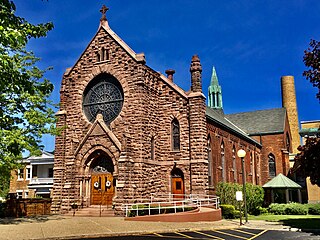
Blessed Sacrament Church is a historic Roman Catholic church in Buffalo, New York, United States. Constructed in the late 19th century, it remains the home of an active congregation and has been recognized as a historically significant building in the Linwood Historic District of Buffalo.























